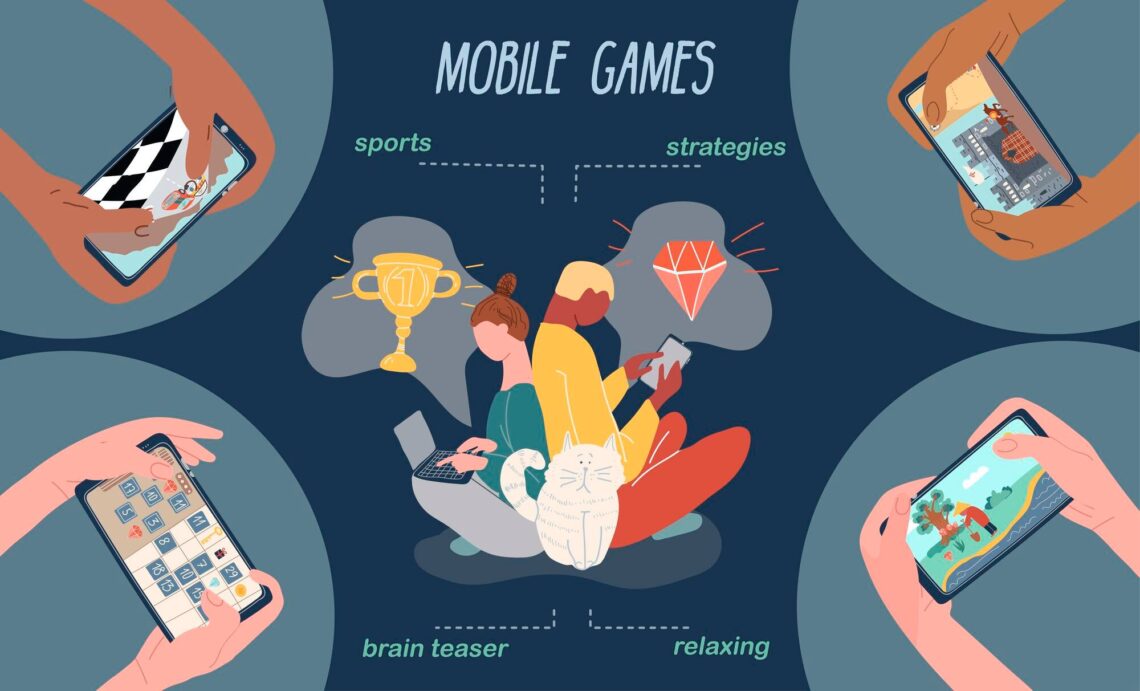Mobile gaming has undergone significant transformation since its inception, growing from the simple games of the 1990s to becoming a global entertainment juggernaut. The evolution of mobile game apps has seen massive improvements in game design, technology, and gameplay mechanics, making mobile gaming one of the most profitable and engaging sectors of the entertainment industry today. In this blog, we’ll explore the history, rise, and future of mobile games.
The Origins of Mobile Gaming
The early days of mobile gaming were quite primitive by today’s standards. In 1997, Nokia introduced Snake on its 6110 mobile phone. This game is widely regarded as the first mobile game to gain massive popularity. The mobile game app development company behind this iconic game was Gremlin Interactive.Though basic in design, Snake demonstrated the potential for entertainment on mobile devices. Its straightforward mechanics—where players navigate a growing snake around the screen without hitting the walls or its own body—resonated with users. Snake’s success set the stage for future mobile games.
At the time, mobile phones were primarily used for communication, but as their computing power increased, so did the demand for entertainment options like games. Before long, Java-based mobile games started appearing in the early 2000s, allowing users to download and play games over basic internet connections.
The Birth of the App Store and Modern Mobile Gaming
The release of the iPhone in 2007 marked the dawn of a new era for mobile gaming. Coupled with the launch of Apple’s App Store in 2008, developers now had a dedicated platform to distribute mobile apps and games, reaching millions of users worldwide. Early hits like Angry Birds (2009) and Doodle Jump became cultural phenomena, showing the global potential of mobile gaming.
The introduction of app stores changed the role of mobile game development services forever. No longer did developers need to rely on deals with telecom providers or pre-installed games on mobile phones. The App Store and Google Play Store democratized mobile game development, giving indie developers and big studios alike the ability to reach a global audience.
The Freemium Model and Monetization Strategies
As mobile gaming matured, so did the methods for monetizing games. The most successful business model to date has been the freemium model. Instead of charging users upfront to download the game, developers made the game free but included in-app purchases (IAPs) for enhancements, such as power-ups, cosmetic items, and game currency. Candy Crush Saga (2012) and Clash of Clans (2012) are prime examples of how this model became a massive revenue generator.
In addition to in-app purchases, many games adopted an ad-based model, where users would see ads in exchange for rewards or to unlock premium features. Mobile game development companies embraced this approach to maximize engagement and retention, offering players the ability to progress faster by watching ads or purchasing in-game items. The combination of freemium models and ads has made mobile gaming one of the most lucrative sectors of the gaming industry.
The Rise of Multiplayer and Social Games
As mobile networks improved and smartphones became more powerful, multiplayer and social gaming took center stage. Pokémon Go (2016) was a revolutionary AR (augmented reality) game that allowed players to interact with virtual Pokémon in real-world locations, making it a global hit. The social component—competing with friends and strangers to catch Pokémon—was a huge factor in its success.
Another example is Fortnite, a cross-platform battle royale game that allows players to compete in real-time across different devices. Fortnite’s mobile version retains the same core mechanics as its PC and console counterparts, providing a seamless experience. This is a clear example of how mobile game app development companies have advanced, offering high-quality multiplayer experiences on mobile.
Social gaming is not limited to competitive experiences. Games like Words with Friends and FarmVille introduced social elements that encourage collaboration or competition with friends. This social layer, combined with the ubiquity of mobile devices, made mobile gaming a communal experience, further driving its appeal.
Technological Advancements in Mobile Game Development
The evolution of mobile gaming can be attributed to several technological advancements. First, the hardware improvements in smartphones have allowed for better graphics, faster processing, and larger storage capacities, making it possible to create games that rival console titles in complexity and beauty.
Second, the emergence of game engines like Unity and Unreal Engine has made it easier for developers to create games with advanced 3D graphics and physics, while also enabling cross-platform development. Developers can now build a game once and deploy it across multiple platforms, including iOS, Android, and even consoles, with minimal rework. This has significantly reduced the time and cost of game development.
Additionally, the rise of cloud gaming is expected to further push mobile gaming into new territory. Cloud gaming services allow users to play high-end games on mobile devices without requiring powerful hardware. Instead, the games run on remote servers, and the visuals are streamed to the user’s device. This technology could enable mobile devices to play graphically intensive games that were previously only available on PCs or consoles.
The Future of Mobile Gaming
The future of mobile gaming looks brighter than ever, with multiple innovations on the horizon. One of the key trends is the integration of virtual reality (VR) and augmented reality (AR). While AR games like Pokémon Go have already demonstrated their potential, we can expect to see more immersive experiences that blend the virtual and physical worlds.
Artificial intelligence (AI) is another area that will drive innovation in mobile game development. AI is being used to create more intelligent NPCs (non-playable characters), personalize gameplay experiences, and even dynamically adjust game difficulty to suit each player’s skill level. As AI continues to evolve, it will open up new possibilities for creating unique and engaging mobile games.
Blockchain technology is also starting to make its way into mobile gaming, particularly through the use of NFTs (non-fungible tokens) and decentralized ecosystems. These innovations could provide players with new ways to own in-game assets and even create player-driven economies where users can trade digital items securely on the blockchain.
Conclusion
The journey of mobile game development has been a remarkable one, with significant advancements in both technology and design over the years. From the simplicity of Snake to the complex, immersive experiences of today, mobile games have evolved into a major part of the global gaming landscape. The role of mobile game app development companies continues to expand as they push the boundaries of what’s possible, offering players around the world new ways to engage, relax, and compete. As we look to the future, with advancements like cloud gaming, AI, and VR, mobile games will undoubtedly continue to be a dominant force in entertainment.
FAQs
- What was the first mobile game app?
The first popular mobile game app was Snake, pre-installed on Nokia phones in 1997. Snake is often credited with introducing the world to mobile gaming and remains one of the most iconic mobile games. - What is the oldest mobile app?
The oldest mobile apps were simple tools like calculators and calendars found on early mobile devices. However, Snake was the first mobile game that gained widespread popularity. - Who created mobile apps?
While mobile apps were initially created by phone manufacturers like Nokia, the modern mobile app ecosystem was revolutionized by Apple’s App Store, which allowed third-party developers to create and distribute apps widely.
4. Which mobile game is the most downloaded in the world?
As of recent data, PUBG Mobile and Garena Free Fire rank among the most downloaded mobile games globally. These games have attracted millions of downloads due to their engaging battle royale format and social elements.
For more games related articles, please visit: https://nytimer.com/category/game/





